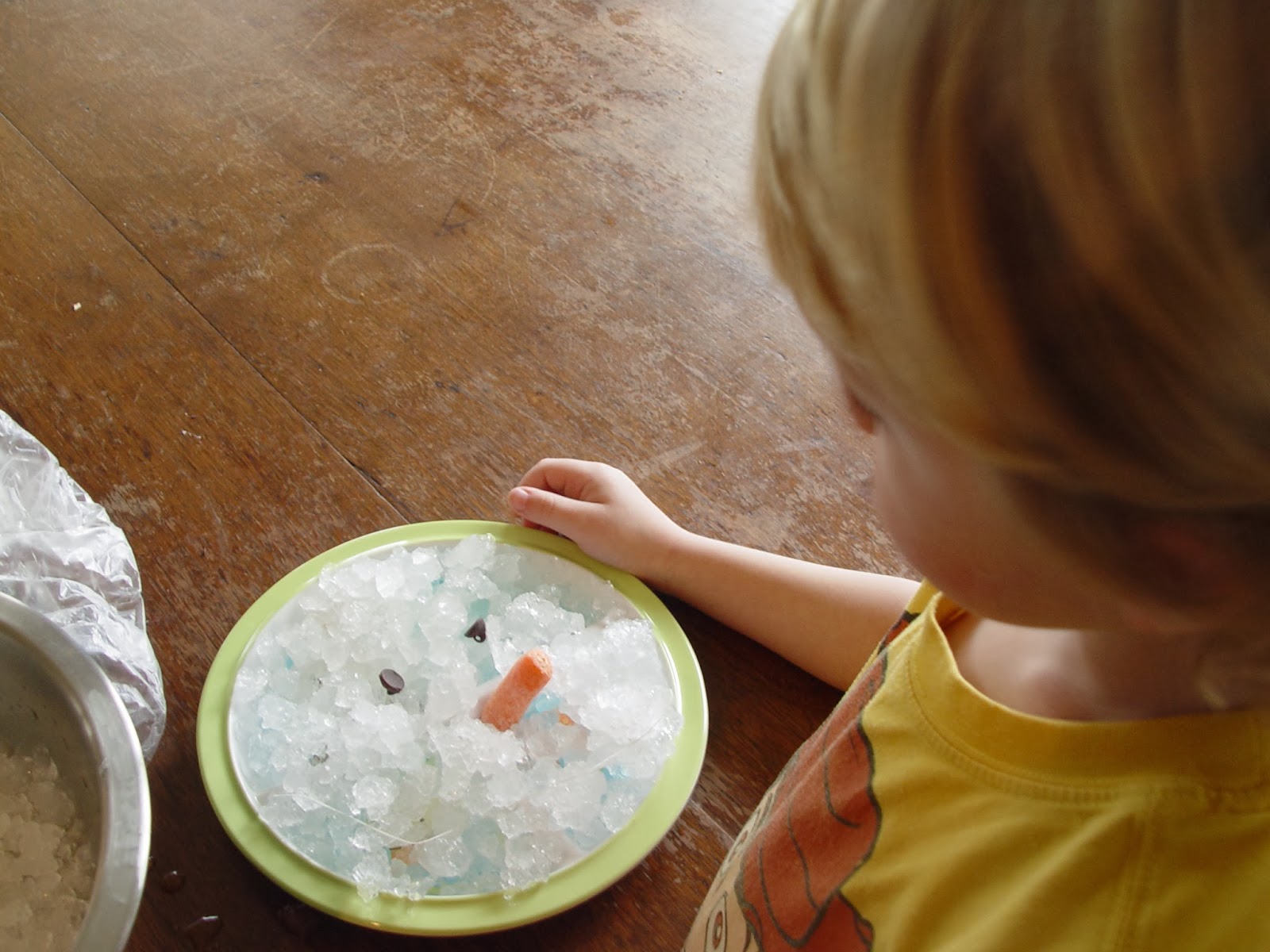So, what in the world is BFIAR you might ask. I describe it a guided reading program for young children. Some might call it a preschool curriculum. There is a long reading list to pick from. You and your children spend 5 days (or more in our case) on the books you choose to row. If you don't have the time or desire to come up with fitting activities yourself, you can buy the unit guide and find the reading list at http://fiveinarow.com/before-five-in-a-row/. I have found so many appropriate activities through Pinterest for the books I've chosen to use that I haven't yet invested in the unit guides, though I might some time in the future.
As I mentioned in the previous post, we just finished a row of The Snowy Day
In the story, the little boy Peter makes a snowball and puts in in his pocket before coming inside. Before bed, he checks on the snowball only to find a wet pocket. I explained to Hayden that when water gets very, very cold, it freezes and forms ice or snow. But when the weather warms up, the ice and snow melt back into water. We demonstrated this by making snow faces out of crushed ice, chocolate chips, carrots, and string (we should have used red yarn, but for some reason, I prepared ecru crochet thread...probably because it was handy at the moment).
We put on of the snow faces in the freezer so it would stay very, very cold and we set the other out on the counter. After a few hours, we checked on the two snow faces and this is what we found.
He was amazed that the one on the counter had melted, but more than anything, just wanted permission to finally eat the chocolate chip eyes. :)
One of the days, we had a water and ice sensory bin. I froze water in several different shaped containers as well as in a few lids. Then filled a dish pan half way up with water. We put the different sized ice cubes/sheets in the water and observed how part of the ice was above the water while part was below the water. We got out our plastic polar animals, some from the Wild Republic Polar in Nature Tube set and some from the Safari Ltd Arctic TOOB
set and some from the Safari Ltd Arctic TOOB set and talked about which animals spent most of their time on land or the ice vs. the water.
set and talked about which animals spent most of their time on land or the ice vs. the water.
We observed how cold the water was after adding ice, which led us to do the "blubber" experiment. I filled a quart sized baggie half full of Crisco. First we put our dry hands straight into the water and observed how cold it felt. Then we put our other hand in the bag of Crisco making sure it was surrounded on all sides by Crisco and submerged it in the water. Hayden said in amazement, "Mommy this hand isn't cold." We talked about how marine mammals like whales, seals, and walruses have a thick layer of blubber under their skin to keep them warm in the cold waters. Unfortunately, this was one of the many activities that I neglected to photograph.
I printed these polar animal flashcards on card stock and used them as part of my bulletin board display.
This was super easy to do. Just heat up a cup of water to just before simmering, and dissolve 2-3 cups of sugar. You'll know when you've added enough sugar when the water becomes so saturated that the sugar will no longer dissolve and the water has become cloudy. Remove the solution from the heat and poor it into a wide mouthed glass canning jar. Suspend your snowflake from a pencil and lay the pencil across the top of the jar so that the snowflake hangs down inside the jar without touching the bottom. If you're using string, you'll need to weight it down with a paper clip. Be sure not to let the paper clip touch the bottom or crystals will form on the bottom of the jar making it very hard to remove the snowflake at the end of the week. Then, just watch the crystals grow.
If you don't see any growth occurring after the first day, your solution wasn't saturated enough. In that case, remove your snowflake and reheat the solution adding a bit more sugar and try again.
For our afternoon snack, a few days in a row, we made snow pretzel stick and marshmallow snowflakes and pretzel stick and marshmallow snowmen. These were so cute, but alas, I again forgot to snap a pic.
Last but not least, we made a lap book using the printable story sequence cards from homeschool creations as well as the snowflakes from the same set of printables (for patterning). For the front of the book, we "built" a snowman. You can't see it in these pics, but under the red flap are two little pockets to hold the snowflake cards and the sequencing cards. I attached sticky Velcro dots to both sets of cards and where I wanted Hayden to put them in the lapbook. I didn't, however, pay close enough attention to whether the hooks or the loops were on the back of the cards, so if he didn't attach them in the same order I originally attached them, we had a problem...live and learn.
Stay tuned for part three.
**As a disclaimer, this post contains affiliate links.**











